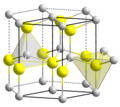Zinc oxide
Zinc Oxide
Zinc oxide is an inorganic compound with the formula ZnO. It is a white powder that is insoluble in water, and it is widely used as an additive in numerous materials and products including rubbers, plastics, ceramics, glass, cement, lubricants, paints, ointments, adhesives, sealants, pigments, foods, batteries, ferrites, fire retardants, and first-aid tapes.
Chemical Properties[edit]
Zinc oxide is an amphoteric oxide. It is nearly insoluble in water but soluble in acids or alkalis. It occurs as white hexagonal crystals or a white powder commonly known as Zinc white. Zinc white crystallizes in the hexagonal system and is essentially the mineral zincite.
Production[edit]
Zinc oxide is produced by three main processes: direct, indirect and wet chemical process. The direct or American process starts with diverse contaminated zinc composites, such as zinc ores or smelter by-products. The indirect or French process starts with the metal zinc. The wet chemical process starts with a solution of a zinc salt.
Applications[edit]
Zinc oxide has a wide range of applications in various fields. In the rubber industry, it is used as a vulcanization accelerator. In the ceramics industry, it is used to make frits, enamels and glazes. In the cosmetics industry, it is used in products such as baby powders, antiseptic creams, anti-dandruff shampoos, and sunscreen lotions. In the pharmaceutical industry, it is used in products such as ointments, creams, and lotions to protect against sunburn and other damage to the skin caused by ultraviolet light.
Health and Safety[edit]
Exposure to zinc oxide in the air, which occurs in the workplace, can result in lung conditions such as metal fume fever. Symptoms of metal fume fever include a metallic taste in the mouth, fever, headache, chest pain, and shortness of breath. Long-term exposure can lead to siderosis, a lung disease which can cause coughing, altered lung function, and reduced pulmonary function.
See Also[edit]
-
Zinc oxide
-
Hopeite
-
Wurtzite polyhedra
-
Sphalerite unit cell
-
Synthetic Zincite Crystals
-
ZnO laser diode
-
ZnO nanorod gas sensor
Ad. Transform your life with W8MD's Budget GLP-1 injections from $75


W8MD offers a medical weight loss program to lose weight in Philadelphia. Our physician-supervised medical weight loss provides:
- Weight loss injections in NYC (generic and brand names):
- Zepbound / Mounjaro, Wegovy / Ozempic, Saxenda
- Most insurances accepted or discounted self-pay rates. We will obtain insurance prior authorizations if needed.
- Generic GLP1 weight loss injections from $75 for the starting dose.
- Also offer prescription weight loss medications including Phentermine, Qsymia, Diethylpropion, Contrave etc.
NYC weight loss doctor appointmentsNYC weight loss doctor appointments
Start your NYC weight loss journey today at our NYC medical weight loss and Philadelphia medical weight loss clinics.
- Call 718-946-5500 to lose weight in NYC or for medical weight loss in Philadelphia 215-676-2334.
- Tags:NYC medical weight loss, Philadelphia lose weight Zepbound NYC, Budget GLP1 weight loss injections, Wegovy Philadelphia, Wegovy NYC, Philadelphia medical weight loss, Brookly weight loss and Wegovy NYC
|
WikiMD's Wellness Encyclopedia |
| Let Food Be Thy Medicine Medicine Thy Food - Hippocrates |
Medical Disclaimer: WikiMD is not a substitute for professional medical advice. The information on WikiMD is provided as an information resource only, may be incorrect, outdated or misleading, and is not to be used or relied on for any diagnostic or treatment purposes. Please consult your health care provider before making any healthcare decisions or for guidance about a specific medical condition. WikiMD expressly disclaims responsibility, and shall have no liability, for any damages, loss, injury, or liability whatsoever suffered as a result of your reliance on the information contained in this site. By visiting this site you agree to the foregoing terms and conditions, which may from time to time be changed or supplemented by WikiMD. If you do not agree to the foregoing terms and conditions, you should not enter or use this site. See full disclaimer.
Credits:Most images are courtesy of Wikimedia commons, and templates, categories Wikipedia, licensed under CC BY SA or similar.
Translate this page: - East Asian
中文,
日本,
한국어,
South Asian
हिन्दी,
தமிழ்,
తెలుగు,
Urdu,
ಕನ್ನಡ,
Southeast Asian
Indonesian,
Vietnamese,
Thai,
မြန်မာဘာသာ,
বাংলা
European
español,
Deutsch,
français,
Greek,
português do Brasil,
polski,
română,
русский,
Nederlands,
norsk,
svenska,
suomi,
Italian
Middle Eastern & African
عربى,
Turkish,
Persian,
Hebrew,
Afrikaans,
isiZulu,
Kiswahili,
Other
Bulgarian,
Hungarian,
Czech,
Swedish,
മലയാളം,
मराठी,
ਪੰਜਾਬੀ,
ગુજરાતી,
Portuguese,
Ukrainian







